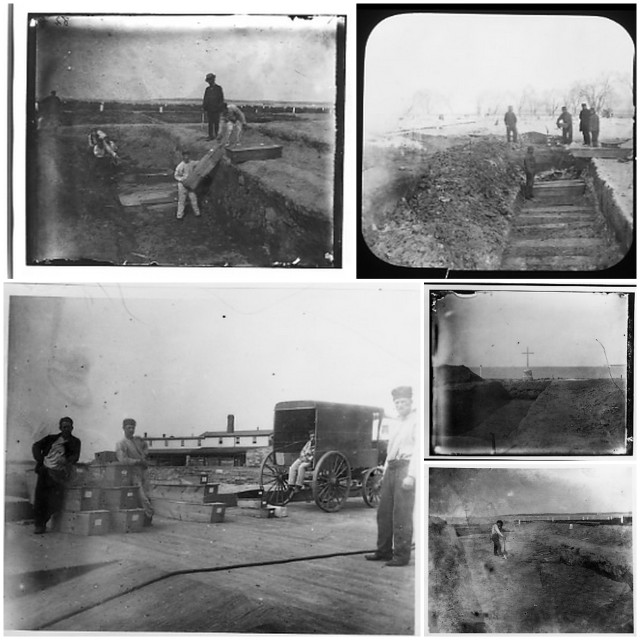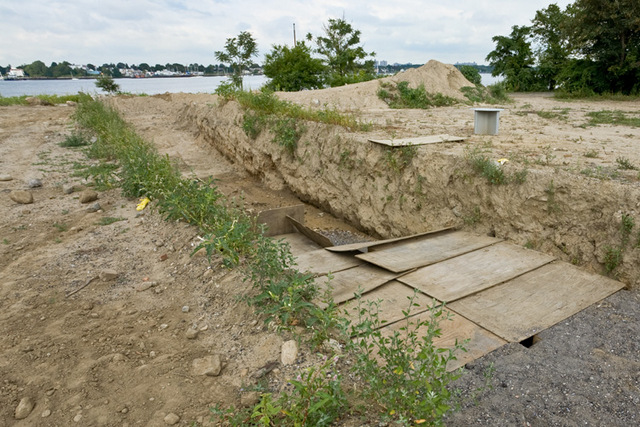This story is a bit of a departure from my usual
postings. Hart Island is not an
archaeological site and not a tourist destination. (Although it has the
potential to become both someday.) It is
a historic site on many levels, but it is not appreciated or interpreted as
such. I had never heard of Hart Island,
and evidently that is true even for most New Yorkers. "Mass Grave" may be an overstatement as each burial was in individual coffins. However, the graves are dug in "mass" fashion with long trenches to hold hundreds of bodies at a time. I find this story fascinating and re-blog it
in its entirety below.
Re-Blogged from: http://gizmodo.com/what-we-found-at-hart-island-the-largest-mass-grave-in-1460171716
What We Found at Hart Island, The Largest Mass Grave Site in the U.S.
By - Kelsey Campbell-Dollaghan,
It’s a place where few living New Yorkers have ever
set foot, but nearly a million dead ones reside: Hart Island, the United
States’ largest mass grave, which has been closed to the public for 35 years.
It is difficult to visit and off-limits to photographers. But that may be about
to change, as a debate roils over the city’s treatment of the unclaimed dead.
Never heard of Hart? You’re not alone—and that’s part of the problem.
Its most important role has been
to serve as what’s known as a potter’s field, a common gravesite for the city’s
unknown dead. Some 900,000 New Yorkers (or adopted New Yorkers) are buried
here; hauntingly, the majority are interred by prisoners from Riker’s Island
who earn 50 cents an hour digging gravesites and stacking simple wooden boxes
in groups of 150 adults and 1,000 infants. These inmates—most of them very
young, serving out short sentences—are responsible for building the only
memorials on Hart Island: Handmade crosses made of twigs and small offerings of
fruit and candy left behind when a grave is finished.
There are a few ways to end up on Hart Island. One
third of its inhabitants are infants—some parents couldn’t afford a burial,
others didn’t realize what a “city burial” meant when they checked it on the
form. Many of the dead here were homeless, while others were simply unclaimed;
if your body remains at the city morgue for more than two weeks, you, too, will
be sent for burial by a team of prisoners on Hart Island. These practices have
given rise to dozens of cases where parents and families aren’t notified in
time to claim the body of their loved one. It can take months (even years) to
determine whether your missing mom, dad, sibling, or child ended up at Hart.
Even
if you do learn that a friend or loved one is buried at Hart, you won’t be able
to find out exactly where. Though Hart Island is the largest publicly funded
cemetery in the world, it’s been closed to the public since 1976, when the
Department of Corrections took control of the site. Family members can request
a visit on the last Thursday of every month, but they aren’t allowed to visit
specific graves—in fact, there’s no official map (not to mention burial
markers) of the mass graves on Hart. The Hart Island
Project, a nonprofit organization led by an artist named Melinda Hunt, is spearheading the fight to
change that: Hunt has worked for decades to convince the city to transfer
control of the island from the DOC to the Parks Department, making it into a
public cemetery in name, as well as in function. |
| Image copyright Joel Sternfeld and Melinda Hunt. From their 1998 book, Hart Island. |
Part
of her self-assigned job is to liaise with family members searching for
information about their loved ones—like Elaine Joseph, a lifetime New Yorker
and veteran who now serves as Secretary of the Hart Island Project. It’s taken
Joseph more than 30 years to find out that her child was buried on the
island—not an unusual scenario, it turns out, though no less heartbreaking.
It’s women like Joseph, who have come forward to tell their stories, who are
helping Hunt to raise awareness of the gross mishandling of Hart Island.
On
a dreary, lukewarm morning last month, Gizmodo—myself and co-worker Leslie
Horn—along with two other reporters, met Hunt and Joseph in the quaint town of
City Island. They had graciously offered to include us on a tour of the island,
and we were about to become some of the first members of the press to visit
since the 1980s.
 |
| Hart Island photographs by Jacob Riis via The Hart Island Project |
35 years ago, Joseph gave birth to a baby girl who needed surgery a few days later. The operation took place at Mount Sinai Hospital during the Great Blizzard of 1978, which shut down the city’s roads and phone lines for days. When a recovering Joseph got through to the hospital, she learned that her baby had died during surgery. Eventually, she was connected with the understaffed city morgue—which informed her that her child had already been buried with other infants. When the death certificate finally arrived, no cemetery was listed.
In city parlance, a blank spot next to the cemetery means one thing: A Hart Island burial. But, in a time before the internet, that fact was lost on anyone without inside knowledge—and Joseph spent the next decade trying to find out where her daughter was buried, visiting the Medical Examiner’s office and digging through the municipal archives. It was as if her child had never been born. “It came to a standstill,” she says, speaking over the phone later. “Over the years, I went on with life.” But every so often, she’d try again—fruitlessly searching the city’s archives for a trace.
 |
| Grave of first child to die of AIDS in NYC, with burial documents. Photo by Melinda Hunt via The Hart Island Project |
A few feet away, a small gravestone represents the only sign of a burial memorial. The stone was paid for by the family of the island’s long-time backhoe operator when he passed away. Behind it, a Victorian-era administrative building, likely left over from the island’s one-time psychiatric hospital, lies in ruins. Any real grave markers that remained were removed years ago by the DOC; today, Hart looks like a dreary but nondescript spit of land you might find anywhere else along the mid-Atlantic.
 |
| An open burial pit next to the wards in the west of the island. Source: Kingston Lounge |
Hunt
and Joseph pull out a pen-marked map (pieced together by Hunt using satellite imagery)
and try to locate the general direction of where her daughter—along with many
other misplaced infants from the same year—might lie. It’s woefully inadequate,
not to mention unnecessary given the advent of GPS. Even if the DOC doesn’t
create markers for each gravesite, they could certainly make the information
available online. But Hart—right down to its decaying Victorian buildings—is
stuck in the past. As Hunt explains, much of the way Hart operates dates from
the Civil War. “This is a very 19th century kind of place,” she adds.
But it doesn’t have to be. Hunt,
who qualifies as nothing short of a hero, is working to extract answers to
painful questions—not only at the personal level, but at a legal one. Do loved
ones have a legal right to visit a family gravesite? In some states—mostly in
the South, where Civil War graves often lie on private land—yes. But, in New
York, things are more ambiguous: State public health laws codify the common law
right to a decent burial, but it is unclear whether that includes the right to
visitation. In 2012, a New York Ob/Gyn named Dr. Laurie Grant, whose stillborn
daughter was buried on Hart Island without her consent in 1993, brought a lawsuit
in New York State Court seeking an injunction against the DOC that would allow
her to visit the gravesite. |
| One of the mass graves that fit up to 150 adult coffins. Source: Kingston Lounge |


Such a sad story Mark. It sounds very much like the Crete story called "The Island " which was once a leper colony.
ReplyDeleteWow. Shocking in these days and times.
ReplyDelete